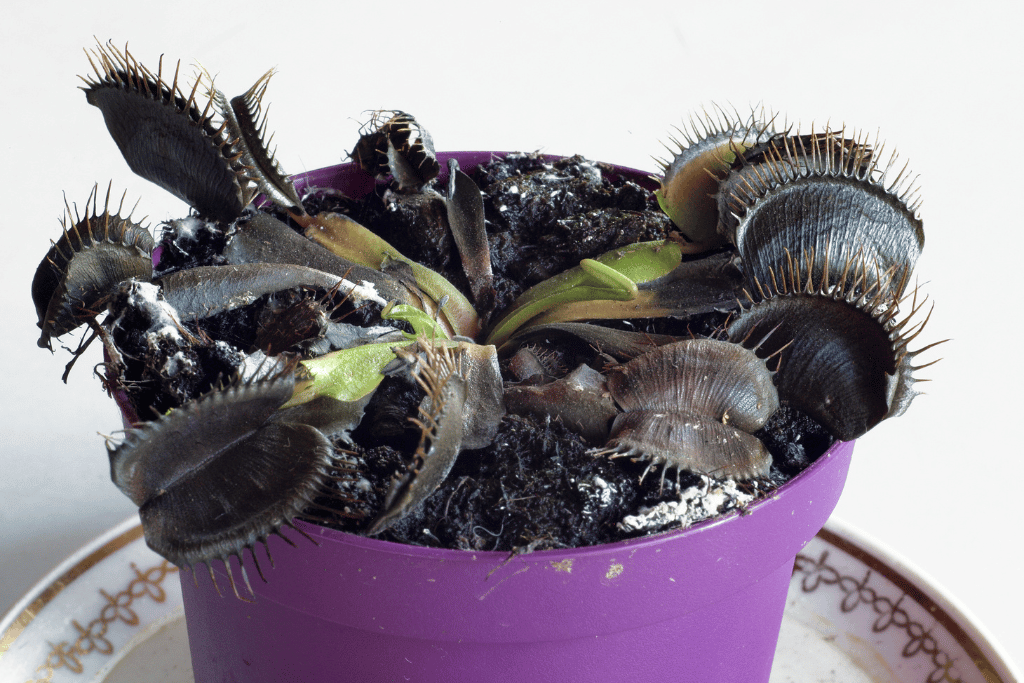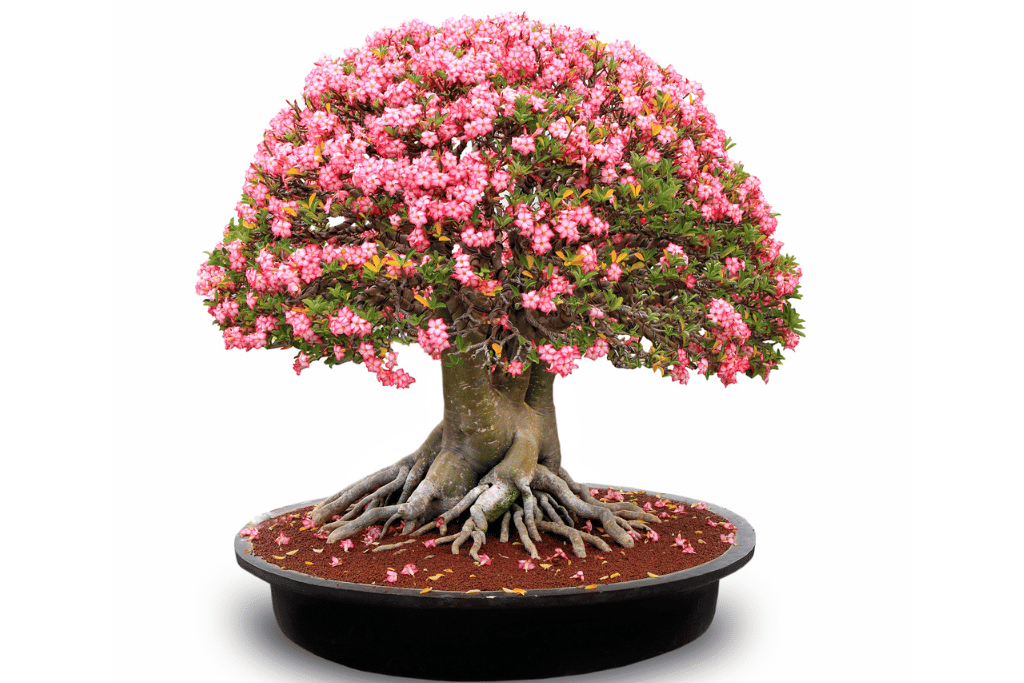Pothos are quite a popular houseplant, most commonly known for their trailing vines and heart-shaped leaves. They are easy to care for, and they’re able to thrive in a variety of lighting conditions, which makes them an excellent choice for beginner and experienced plant owners alike. Though, one of the most essential aspects of pothos care is watering. In this article, I’ll discuss everything you need to know about how often to water pothos.
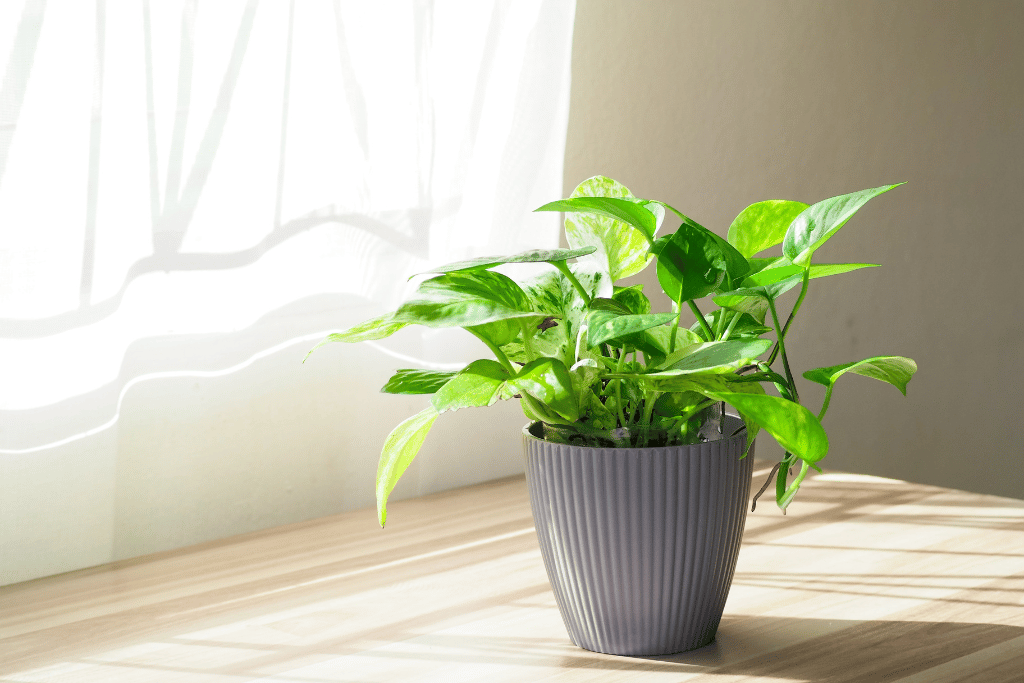
1. Understanding the Watering Needs of Pothos
Before we explore the specifics of watering pothos, we need first to understand the watering needs of the pothos plant. Pothos plants prefer to be kept in moist soil, but they don’t like to be overwatered. Overwatering can lead to root rot and other issues, such as nasty bacteria and fungi forming, so it’s crucial to find the correct balance between overwatering and underwatering.
In general, pothos should be watered when the top inch of their soil is dry to the touch. How fast this happens will depend on the conditions in your home, so this could mean that you would be watering your pothos at least once a week or once every two weeks. It’s important to remember that every plant is different, though, so you should always pay attention to the specific needs of your pothos by just checking the soil’s moisture before watering.
2. Choosing the Right Pot For Your Pothos
The first step to watering your pothos correctly is to choose the right pot for it. Ideally, it would be best if you were using a pot with drainage holes to make sure that excess water can drain out of the soil. If your pot doesn’t have drainage holes, you need to be more careful about not overwatering your plant – root rot can onset easily due to the standing water.
3. How to Water Pothos
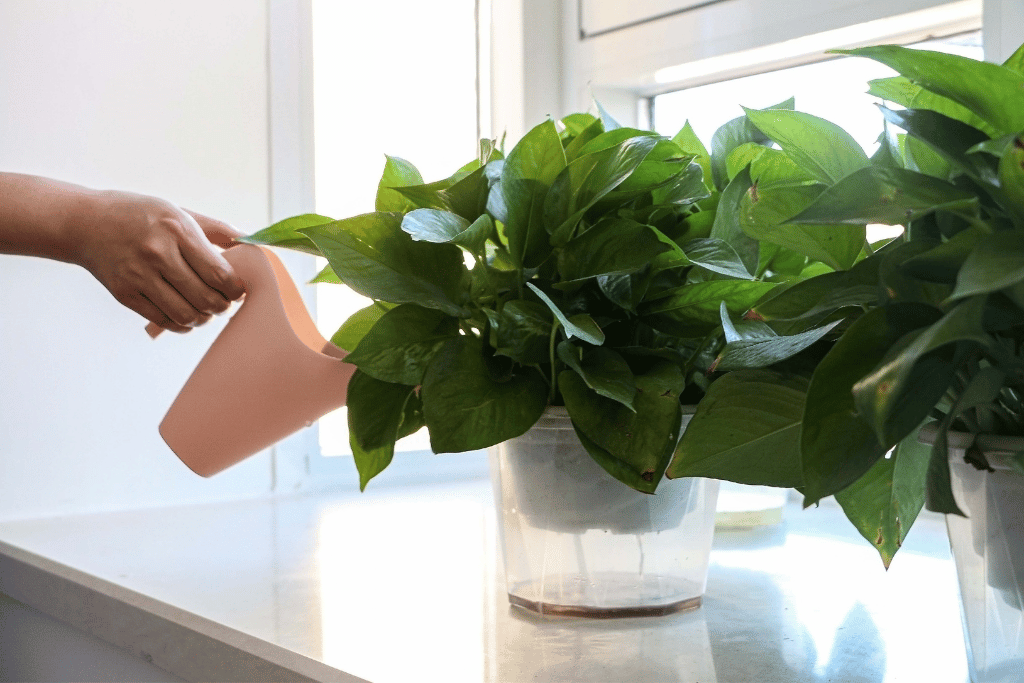
When you think it’s time to water your pothos, there are a few steps you should follow before doing so:
- Check the soil: Before you water your plant, check the soil to see if it’s dry or not. If the top inch of soil feels dry to the touch, then it might be time to water your pothos. If you find that it isn’t drying out for weeks at a time, your pothos may not be receiving enough light or is in an environment where the temperatures are not warm enough (unless it’s winter)
- Water slowly: When watering your pothos, you should do it slowly. This gives the soil time to absorb the water without it running straight through to the drainage holes.
- Water thoroughly: When watering your pothos – don’t just give them a few drops of water. Make sure that you water the plant thoroughly, as we want the water to reach all the way to the roots to keep them healthy.
- Allow the water to drain: Once you’ve finished watering your pothos, allow any excess water to drain out of the container through the drainage holes. We don’t want the soil to become waterlogged, as not enough oxygen will be able to reach the roots and, therefore, will lead to root rot.
4. How To Tell If You’re Overwatering or Underwatering Your Pothos
A tricky aspect of taking care of pothos is knowing when you’re underwatering or overwatering your plant. Overwatering will cause the leaves to turn yellow or brown, and the plant will eventually wilt. Underwatering will cause the leaves to become dry and brittle, typically turning brown.
If you’re not sure whether you’re underwatering or overwatering your pothos, there are a few signs you can look out for. If the soil is remaining damp constantly or the leaves are turning brown or yellow, this is a common sign that you may be overwatering your plant. If the leaves are brittle and dry, you may very well be underwatering your plant.
5. Tips for Watering Pothos
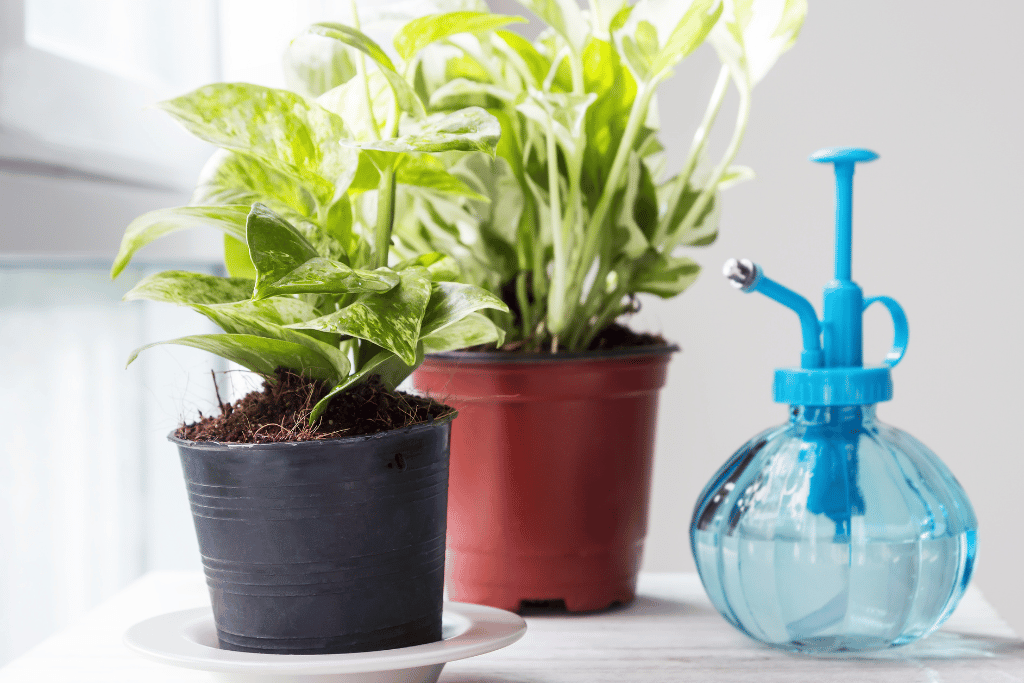
Here are a few additional tips to keep in mind when you’re watering your pothos plant:
- Use room temperature water: When watering pothos, it’s best to use room-temperature water. Cold water can shock the roots due to the drastic temperature change, and hot water can damage the plant.
- Try not to water from the top of the plant: Watering from the top can lead to water sitting on the leaves, which may not evaporate – therefore leading to the leaves rotting. Instead, opt for watering from the bottom to ensure that the roots are getting all the water that they need.
- Consider implementing a watering schedule: While I don’t personally use a watering schedule (I go by the moisture of the soil), this may be helpful for some people who regularly need to remember to water their plants. You can use something such as a calendar or reminder app to help you keep track of when it’s time to water your plant.
- Adjust the watering frequency based on the season: During the warmer months, your pothos will have an increased water demand, meaning that you’ll have to water them more frequently than in the colder months. Pay close attention to the moisture in the soil and adjust your watering schedule accordingly.
- Use a moisture meter: If you’re still having trouble determining when to water your pothos, it might be a good idea to invest in a moisture meter. This will help to accurately determine the moisture level in the soil, letting you know when to water your plant.
- Use a watering can: Watering cans will help you to control the flow of water and prevent you from overwatering your pothos – it’s also easier to water from the bottom with a watering can.
6. Watering Frequency
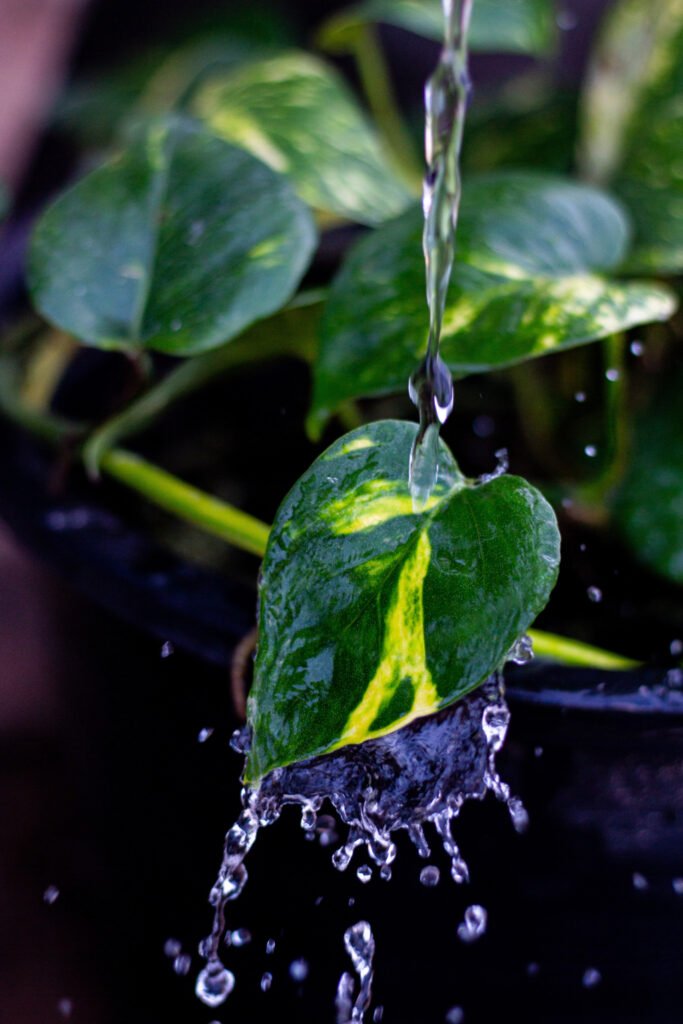
How often you water your pothos will depend on the temperature, light conditions, soil type, humidity and pot size. Pothos enjoy being in moist soil, but it’s vital that they aren’t kept in soggy conditions for long periods of time. Overwatering will cause root rot and other diseases to form. Overwatering will cause the leaves to wilt and eventually drop, leading to the overall decline of the plant. Therefore, it’s necessary that you manage to find a balance between the two. Check the moisture of the soil regularly to determine the watering frequency. You can stick your finger or a moisture meter into the soil to test the moisture level – if the soil feels dry to the touch, then it’s time to water your pothos. On average, though, pothos will need watering around once a week.
7. Watering Techniques
There are two different techniques you can use for watering pothos; top watering and bottom watering.
Top watering is where water is poured directly onto the surface of the soil or onto the leaves. I don’t recommend top-watering houseplants as it can cause the soil to become waterlogged and increase the risk of fungal diseases. Additionally, the water droplets can settle on the leaves and influence the growth of bacteria and fungi, leading to additional problems.
Bottom watering is what I would recommend for pothos. This involves filling a saucer beneath the pot with water, allowing the soil to soak up the water from the drainage holes at the bottom of the pot. I let the plant do this for around 10-15 minutes, removing the excess water from the saucer after this. Bottom watering will ensure that the roots receive a good amount of water without the risk of waterlogging happening.
8. Water Quality
Although pothos is not a sensitive plant, it’s a good idea to use good quality water for watering your plants. The best water for pothos is tap water that’s been left to sit for around 24 hours, allowing chlorine and other chemicals to evaporate out. If you have particularly hard water, you could consider using filtered or distilled water, as the minerals contained in hard water can accumulate in the soil over time, which can lead to nutrient deficiencies and pH imbalances.
9. Potting Soil
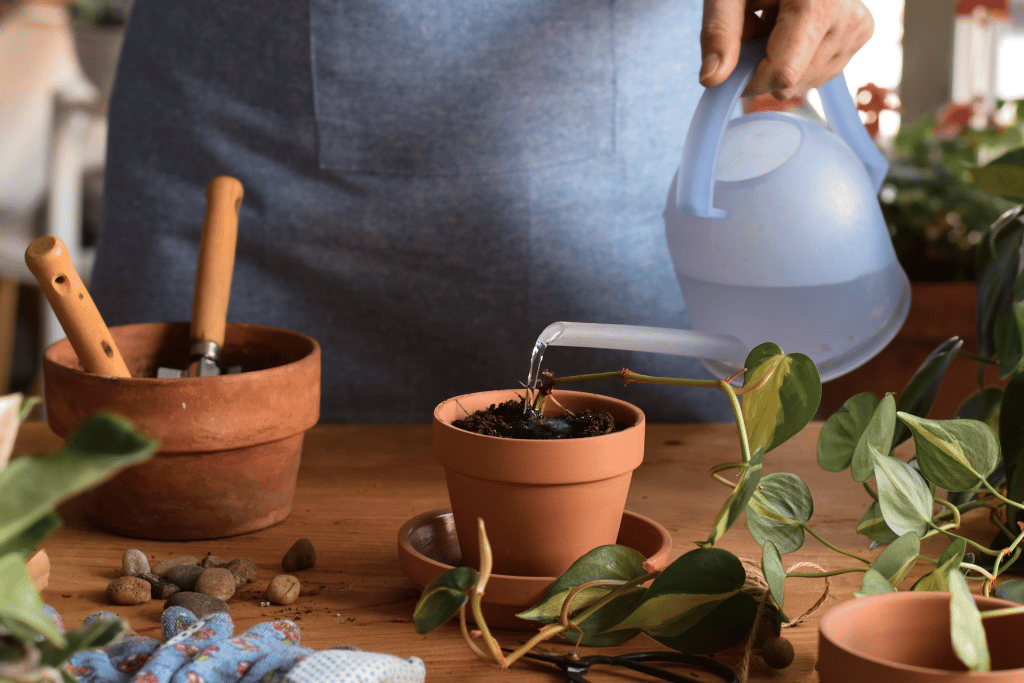
Pothos prefer to be kept in well-draining soil, and their potting mix should consist of a combination of substrates such as peat moss, vermiculite and perlite. Perlite and vermiculite will improve the aeration of the soil and drainage, while peat moss will help to retain moisture. Additionally, you can add a slow-release fertilizer to the potting mix to provide a good amount of nutrients to the pothos.
10. Pot Size
Pothos are able to grow in a wide range of different pot sizes, but it’s essential that you choose the correct size pot to make sure that the plant grows well. A pot that is too small can cause the soil to dry out too quickly, while a pot that is too large can cause the soil to become waterlogged, causing root rot. A good rule of thumb is to make sure that you choose a pot that is one size larger than the current pot you use – additionally, ensure that the pot has drainage holes to allow excess water to drain out.
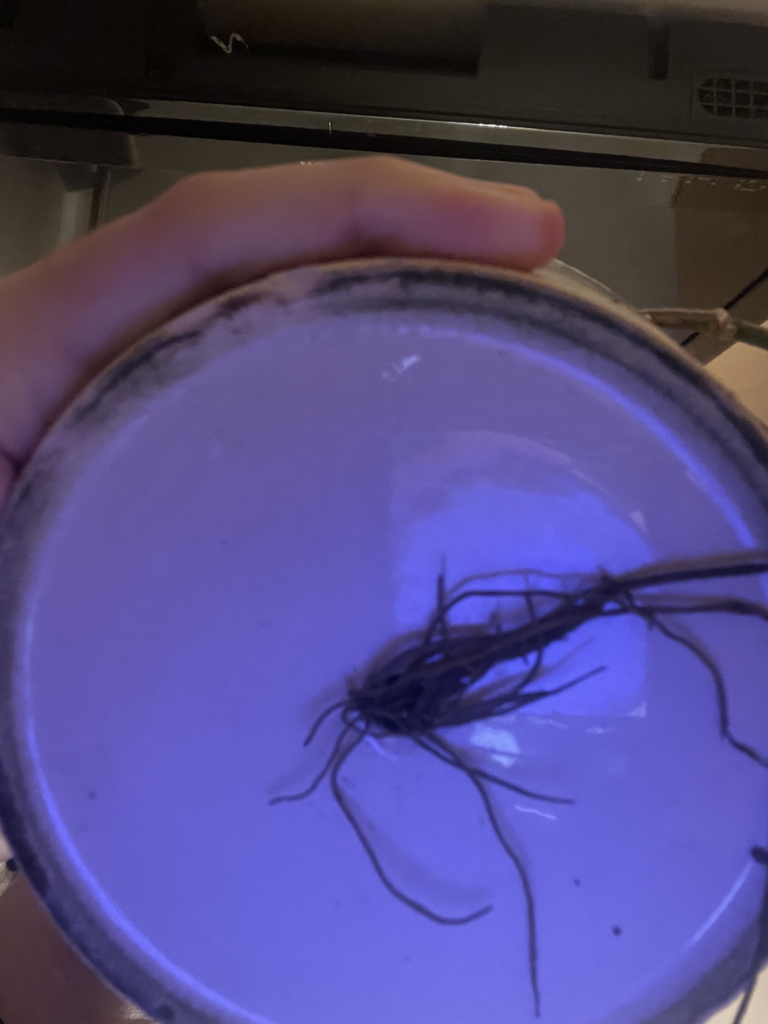
11. Humidity
Pothos prefer to be kept in high humidity levels. Low humidity can cause the leaves to brown and dry out – you can increase the humidity levels by misting the plant regularly, placing a humidity tray under the pot or simply by grouping the plant up with other plants.
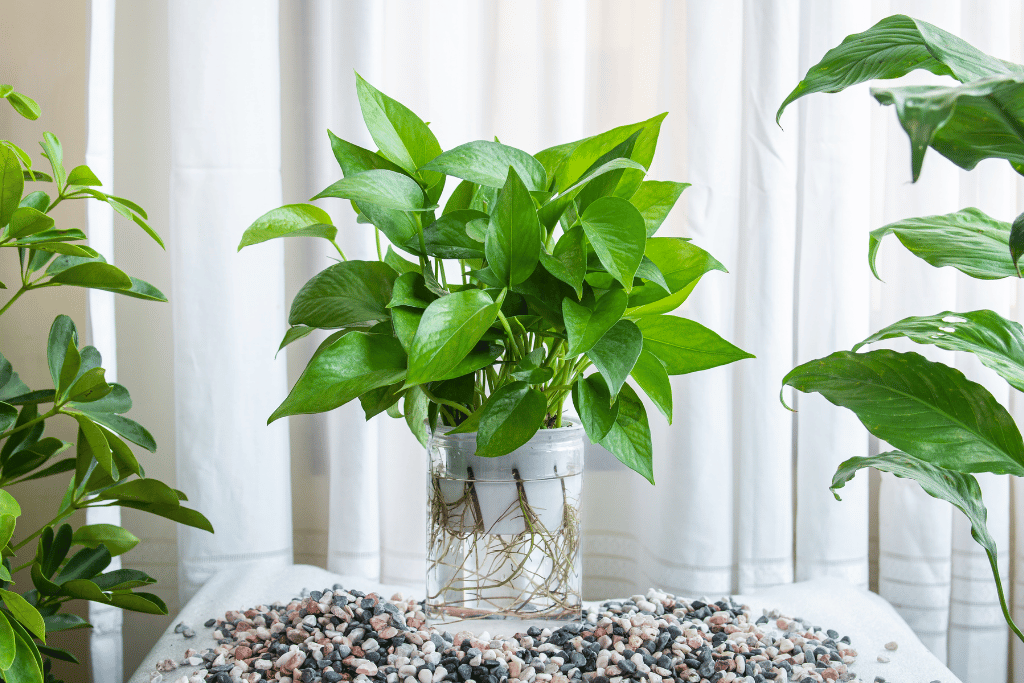
12. Signs of Overwatering and Underwatering
Overwatering and underwatering are common problems with pothos, and they can cause significant damage to the plant. Overwatering can lead to root rot, yellowing leaves and drooping and damaged stems. Underwatering can cause the leaves to wilt and turn brown. It’s essential to pay attention to the plant’s leaves and stems to detect signs of overwatering and underwatering. If you notice any of these signs, it’s vital that you adjust the watering frequency accordingly.
Overall, pothos is a low-maintenance and hardy plant which is able to thrive in various different lighting conditions – though proper watering is critical to the survival and growth of the plant. As discussed above, it’s essential to choose the right pot size, watering technique and potting mix. Pay attention to the humidity levels, water quality and any signs of underwatering and overwatering that occur.
While watering pothos may seem like a simple task to more experienced growers, it can be challenging for new plant owners. It’s easy to overwater and underwater the plant, which can cause harm to its health. Though, with a little bit of patience and attention, you’ll quickly master the art of watering pothos in no time.
In addition to proper watering, here are a few last tips to make sure that your pothos grows healthy and strong:
- Fertilizing: Pothos will benefit from regular fertilization in the growing season – use a balanced liquid fertilizer once a month to provide all of the essential nutrients to the plant.
- Pruning: Regular pruning will help to promote bushy growth and prevent the plant from becoming leggy. You should remove any yellowing or dead leaves, trimming back any overgrown stems.
- Repotting: Ideally, pothos should be repotted around every two to three years to provide fresh soil for them and room for new root growth. When repotting your pothos, make sure to go up a pot size and use fresh potting mix.
- Pest control: Pothos are relatively resistant to pests, but they can still attract pests like scale insects, mealybugs and spider mites. If you notice any signs of these pests, isolate the plant and treat it with a natural or chemical pesticide.
As long as you follow these care tips and remember to water your pothos correctly, you’ll be able to enjoy a healthy and vibrant plant for many years to come. Remember to be patient and give the plant the care it needs to thrive. With a bit of effort and attention, you’ll find beautiful new growth on your pothos in no time.
Frequently Asked Questions (FAQ)
Can pothos go three weeks without water?
Pothos will likely die after around three to four weeks without being watered, but sometimes they can be revived depending on how severe it is. In winter, they might be able to survive not being watered for this period of time, but it’s likely that in summer, they won’t be able to survive this. Though, just because they can survive this, it doesn’t mean that you should do it. Dehydrated and wilted pothos can sometimes be brought back to life by soaking them from the bottom with water mixed in with seaweed. This should be done for around 10-15 minutes, repeating every week for approximately two to three weeks.
How can you tell if pothos is healthy?
You can tell if a plant is healthy primarily by its leaves. If the leaves are glossy, green and perky, then it’s likely that the plant is doing well. If they’re wilting or turning brown, though, it’s likely that it’s not doing so well and that you need to adjust how often you’re watering your plant. You should note that not all plants can generally be diagnosed just through their leaves, though. Even though they are not houseplants, junipers typically won’t tell you that they’re dying for a few months until they start to brown!
Do pothos like to climb or hang?
Naturally, pothos like to climb and ramble, so once you give them a direction to climb in, it’s likely that they’ll start naturally growing in that direction. Before trying to get a pothos to climb up a support structure, though, it’s best to make sure that it’s established in your growing conditions and in a healthy state. To influence growth in a certain direction, it might be a good idea to tie it to the support structure and increase light towards the area you want it to grow towards – this is phototropism (where plants grow towards light).
Do pothos like to be in a window?
Pothos will do best growing in bright and indirect light – if it’s not getting enough light, the leaves will likely start to lose their variegation and become smaller. If you keep your pothos on a west facing window close to the glass, it’s likely that the leaves of your pothos may burn. Therefore, it’s best to keep it a few feet away from the window or keep it on a windowsill that faces north or east.


